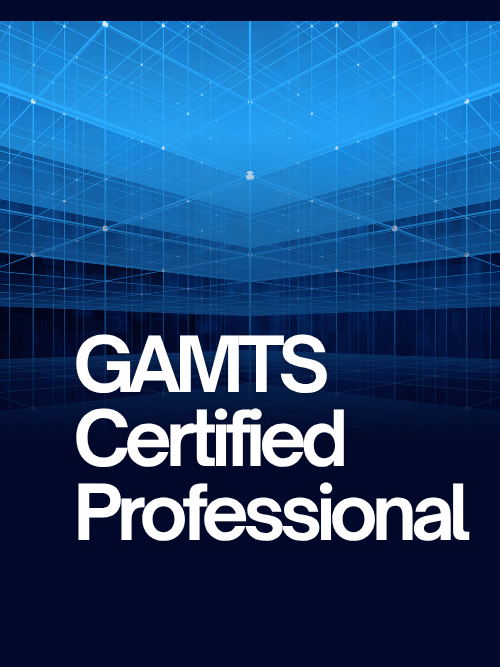GAMTS Certified AI Strategy Architect (GMAI)
Schedule Exam Lead AI Transformation Across Your Organization
Overview
What is GMAI Cerificate
The GAMTS Certified AI Strategy Architect (GMAI) is a premier, lifetime-valid credential designed for strategic leaders, CTOs, enterprise architects, and business executives responsible for developing and implementing AI initiatives at organizational scale. As an independent, vendor-neutral global certification authority, GAMTS validates your expertise in AI strategy formulation, governance, implementation roadmaps, risk management, and organizational change management. This certification positions you as a trusted advisor capable of driving enterprise AI transformation while ensuring ethical, compliant, and sustainable adoption aligned with business objectives and global standards.
Complete Study Syllabus
1.1 Understanding AI, ML, and Deep Learning
Definitions and distinctions between AI, Machine Learning, and Deep Learning
Current state of AI technology and capabilities
AI vs. traditional automation and analytics
Common AI misconceptions and hype vs. reality
AI's transformational potential across industries
1.2 AI Technology Landscape
Types of AI: Narrow AI, General AI, Superintelligent AI
Supervised, unsupervised, and reinforcement learning
Neural networks and deep learning architectures
Natural Language Processing (NLP) and Computer Vision
Generative AI and Large Language Models (LLMs)
1.3 AI Market Trends & Industry Impact
Global AI market size, growth projections, and investment trends
AI adoption rates by industry and region
Competitive landscape and leading AI platforms
Real-world AI success stories and failure case studies
Future AI trajectory and business implications
2.1 AI Strategy Formulation
Developing comprehensive AI roadmaps aligned with business objectives
AI strategy frameworks and methodologies
Competitive advantage through AI differentiation
Long-term value creation vs. short-term gains
AI's role in digital transformation initiatives
2.2 Business Case Development
Building compelling AI business cases with ROI projections
Cost-benefit analysis for AI investments
Financial modeling and budget justification
Stakeholder communication and executive buy-in
Measuring AI business impact and value realization
2.3 Portfolio Management & Prioritization
AI portfolio management and initiative prioritization
Balancing innovation, risk, and resource allocation
Quick wins vs. long-term strategic investments
Multi-project AI portfolio optimization
Industry-specific AI opportunities and applications
3.1 Use Case Identification
Systematic discovery of high-value AI opportunities
Use case workshops and ideation methodologies
Problem definition and opportunity framing
Cross-functional collaboration for use case discovery
Industry benchmarking and best practices
3.2 Feasibility Assessment
Technical feasibility evaluation (data, algorithms, infrastructure)
Business feasibility analysis (ROI, impact, alignment)
Data requirements and data quality assessment
Model complexity vs. business value trade-offs
Risk assessment for use case implementation
3.3 Pilot Design & Scaling Strategy
Proof-of-concept (PoC) and pilot program design
Success criteria and KPI definition
MVP (Minimum Viable Product) approach
Scaling proven use cases to production
Lessons learned and iterative improvement
Real-World Examples:
Customer churn prediction
Predictive maintenance
Fraud detection systems
Personalization engines
Supply chain optimization
4.1 AI Ethics Principles
Ethical frameworks for AI (IEEE, EU, OECD principles)
Fairness, transparency, and accountability (FTA)
Human-centric AI design
Social responsibility and societal impact
Ethical decision-making in AI governance
4.2 Bias Detection & Mitigation
Types of bias in AI systems (data, algorithmic, human)
Bias detection methodologies and tools
Mitigation strategies and fairness metrics
Diverse data sets and inclusive design
Ongoing monitoring for bias drift
4.3 Explainability & Trust
Explainability requirements and techniques (XAI)
Interpretability vs. black-box models
Building stakeholder trust in AI systems
Transparency in AI decision-making
Communication of AI limitations
Frameworks Covered:
IEEE Ethically Aligned Design
EU AI Act ethical requirements
NIST AI Risk Management Framework
OECD AI Principles
5.1 AI Governance Structures
AI governance frameworks and oversight mechanisms
AI steering committees and decision-making bodies
Roles and responsibilities (RACI models)
Policy development and approval workflows
Cross-functional governance coordination
5.2 AI Risk Management
AI-specific risk taxonomy and assessment
Model risk management and monitoring
Operational risks in AI systems
Third-party AI vendor risk management
Insurance and liability considerations
5.3 Regulatory Compliance
EU AI Act: risk tiers and compliance requirements
GDPR implications for AI/ML systems
Industry-specific regulations (healthcare HIPAA, finance SOX, etc.)
Data residency and sovereignty requirements
Export controls and international compliance
Governance Components:
Model performance monitoring dashboards
Incident response for AI failures
Audit trails and documentation requirements
Change management and version control
6.1 AI Platform Evaluation
Cloud AI platforms (AWS, Azure, GCP) - vendor-neutral comparison
On-premises vs. cloud vs. hybrid AI infrastructure
Open-source tools (TensorFlow, PyTorch, scikit-learn)
Enterprise AI platforms (Databricks, DataRobot, Palantir)
Vendor lock-in considerations and mitigation
6.2 Architecture Design
Model development, training, and deployment architectures
Data pipelines and feature engineering infrastructure
MLOps and model lifecycle management
Scalability and performance optimization
Integration with existing enterprise systems
6.3 Cost Optimization
AI infrastructure cost drivers and optimization strategies
Cloud cost management and resource allocation
Build vs. buy vs. partner decisions
Total cost of ownership (TCO) analysis
ROI measurement and financial tracking
7.1 Organizational Readiness Assessment
Maturity models for AI readiness
Culture, capabilities, and technology assessment
Gap analysis and improvement roadmaps
Leadership readiness and sponsorship
Data maturity and infrastructure evaluation
7.2 Talent & Skills Development
AI talent market landscape and skill requirements
Recruitment and retention strategies
Training and upskilling programs for existing staff
Building data science and AI teams
Cross-functional collaboration models
7.3 Change Management & Culture
Change management frameworks for AI adoption
Addressing employee anxiety and resistance
Building innovation and experimentation culture
Knowledge transfer and organizational learning
Centers of Excellence (CoE) operating models
Organizational Components:
Role definitions (Data Scientist, ML Engineer, AI Architect)
Team structures and reporting lines
Compensation benchmarks for AI talent
Skill development pathways
8.1 Implementation Planning
Phased implementation approaches and timelines
Agile methodologies for AI projects
Quick wins and momentum building
Stakeholder management and communication plans
Risk management throughout implementation
8.2 Managing Technical Complexity
Integration with legacy systems
Technical debt management
Data migration and quality assurance
Testing and validation strategies
Performance monitoring and optimization
8.3 Measuring Success
KPI definition and tracking
AI success metrics (technical and business)
ROI measurement and reporting
Continuous improvement frameworks
Lessons learned documentation
9.1 Industry-Specific Applications
Healthcare & Pharmaceuticals:
Diagnostic AI and clinical decision support
Drug discovery acceleration
Regulatory compliance (FDA, HIPAA)
Financial Services:
Fraud detection and risk management
Algorithmic trading
Regulatory oversight (Basel III, MiFID II)
Retail & E-Commerce:
Recommendation engines
Demand forecasting and dynamic pricing
Supply chain optimization
Manufacturing & Industrial:
Predictive maintenance
Quality control and defect detection
Production scheduling
Telecommunications:
Network optimization and customer churn prediction
Government & Public Sector:
Service delivery optimization and fraud detection
10.1 Success Metrics & KPIs
Financial impact metrics (ROI, cost savings, revenue growth)
Business outcome tracking
Model performance vs. business metrics
Portfolio-level optimization
Stakeholder satisfaction measurement
10.2 Continuous Monitoring & Optimization
Dashboard design and KPI tracking
Model drift detection and retraining
Performance degradation response
A/B testing and experimentation
Continuous improvement processes
10.3 Value Communication
Executive reporting and storytelling with data
Board-level presentations
Stakeholder value communication
Celebrating wins and addressing failures
11.1 Emerging AI Technologies
Generative AI and Large Language Models (LLMs)
Quantum computing implications for AI
Edge AI and distributed inference
Federated learning and privacy-preserving AI
11.2 Future of AI
AI regulation evolution (EU AI Act, US policy)
Artificial General Intelligence (AGI) timeline
Global AI governance trends
Skills requirements evolution
Organizational adaptability strategies
11.3 Preparing for the Future
Building future-ready AI strategies
Scenario planning and strategic foresight
Innovation management and R&D
Competitive positioning for AI future
12.1 Complex Strategic Scenarios
Multi-domain integrated scenarios requiring strategic thinking
Trade-off analysis (cost vs. speed vs. quality)
Crisis management and rapid response
Ethical dilemma resolution
Stakeholder conflict resolution
12.2 Real-World Case Study Analysis
Successful AI transformation examples
Failure analysis and lessons learned
Industry-specific implementation challenges
Cross-functional leadership decisions
Continuous Updates: Curriculum and study guide updated annually to meet market changes
Target Audience
Strategic technology leaders, CTOs, CIOs seeking advanced AI credentialing
Enterprise and solution architects designing AI initiatives
Executive leaders and product managers guiding AI transformation
Consultants advising organizations on AI adoption and strategy
Business strategists integrating AI into competitive advantage
Governance, risk, and compliance professionals overseeing AI programs
Experience: 7+ years in technology leadership, strategy, or enterprise architecture (recommended)
Exam Pattern
Process
To maintain the integrity and quality of GAMTS certifications, purchasing the Official Study Guide + Exam Voucher Bundle is mandatory.
-
Step 1
Purchase Bundle
Buy the Official GMCS Study Guide + Exam Voucher Bundle on this page. Instant download of study materials and exam voucher to your GAMTS account. -
Step 2
Prepare & Write Exam
Use the comprehensive guide to prepare at your own pace (no training sessions required). Complete the 3-hour online exam from any location with secure proctoring. -
Step 3
Receive Results & Certificate
Upon passing, receive your GMCS certificate instantly via email.
Ready to Certify?
Apply for certification Have Questions? Contact our certification advisors at certifications@gamts.org.
Insights/Resources
Expert insight and analysis on the latest trends.
3 Common Mistakes in Cyber Risk Quantification (And How to Avoid Them)
How a CCRS Certified Professional Reduced Cyber Insurance Premiums by 35%
PayPal launches PYUSD stablecoin for payments and transfers
Revolutionizing the Future of Financial Services
Testimonial
“The GMCS credential empowered me to lead global cloud security transformations. The vendor-neutral approach makes it stand out internationally.”
— Fatima Ahmed, Cloud Security Director, UAE
Career Acceleration: Secure promotions, specialized roles, and leadership opportunities
Benefits & Industry Value
Independent & Vendor-Neutral
We certify your skills, not products. GAMTS has no affiliation with any technology vendor, ensuring impartial, objective standards that remain valuable across all platforms and technologies.
Lifetime Validity – No Renewal Fees
Your GAMTS certification is valid for life. No recurring costs, no expiration dates, no mandatory renewals. Your achievement is recognized forever.
Global Recognition – 50+ Countries
GAMTS certifications are trusted by enterprises, governments, and regulators worldwide. Your credential opens doors across continents.
Rigorous, Transparent Standards
Our certification standards are developed by subject matter experts, industry bodies, and global frameworks (NIST, ISO, IEEE). Integrity is non-negotiable.
Self-Paced, Flexible Learning
No mandatory training. No fixed schedules. Study at your own pace using our comprehensive official materials. Exam available 24/7, whenever you're ready.
Affordable, Transparent Pricing
One-time bundle purchase covers study guide and unlimited exam attempts within 12 months. No hidden fees, no surprise costs, no renewal traps.
Career Advancement & Higher Compensation
GAMTS-certified professionals report average salary increases of 35% and career advancement to leadership roles within 12-24 months.
Nonprofit Mission – Your Success Matters
GAMTS is nonprofit. We reinvest all proceeds into better standards, research, and candidate support—not shareholder profits. Your certification funds excellence.
Join 10,000+ certified professionals committed to ethical practice, continuous learning, and industry excellence. Network, collaborate, grow.
FAQs About GMAI Certificate
7+ years in technology leadership, strategy, or enterprise architecture is recommended. However, exceptional candidates with 5+ years combined with strong strategic business acumen may be considered.
GMAI is valid for life—no expiration date and no renewal fees. Maintain your credential forever, provided you adhere to GAMTS code of ethics and professional standards.
Absolutely. GMAI is trusted by organizations in 50+ countries, including Fortune 500 companies, government agencies, and major consulting firms. Employers globally recognize GAMTS as a credible, vendor-neutral certification authority.
Yes, completely vendor-neutral. GMAI focuses on AI strategy, governance, organizational transformation, and best practices applicable across all platforms and technologies. You'll gain strategic acumen that translates to any vendor or technology stack.
Yes. The exam is entirely online and proctored globally. You can schedule and take the exam from any location with reliable internet access. GAMTS supports 24/7 exam scheduling across all time zones.
Exceptional. Demand for AI strategy leadership is growing 40% annually. GMAI-certified professionals report career advancement to Chief AI Officer, VP AI, and executive roles within 12-24 months. Compensation ranges globally: $150K-$350K+ depending on experience and market.






